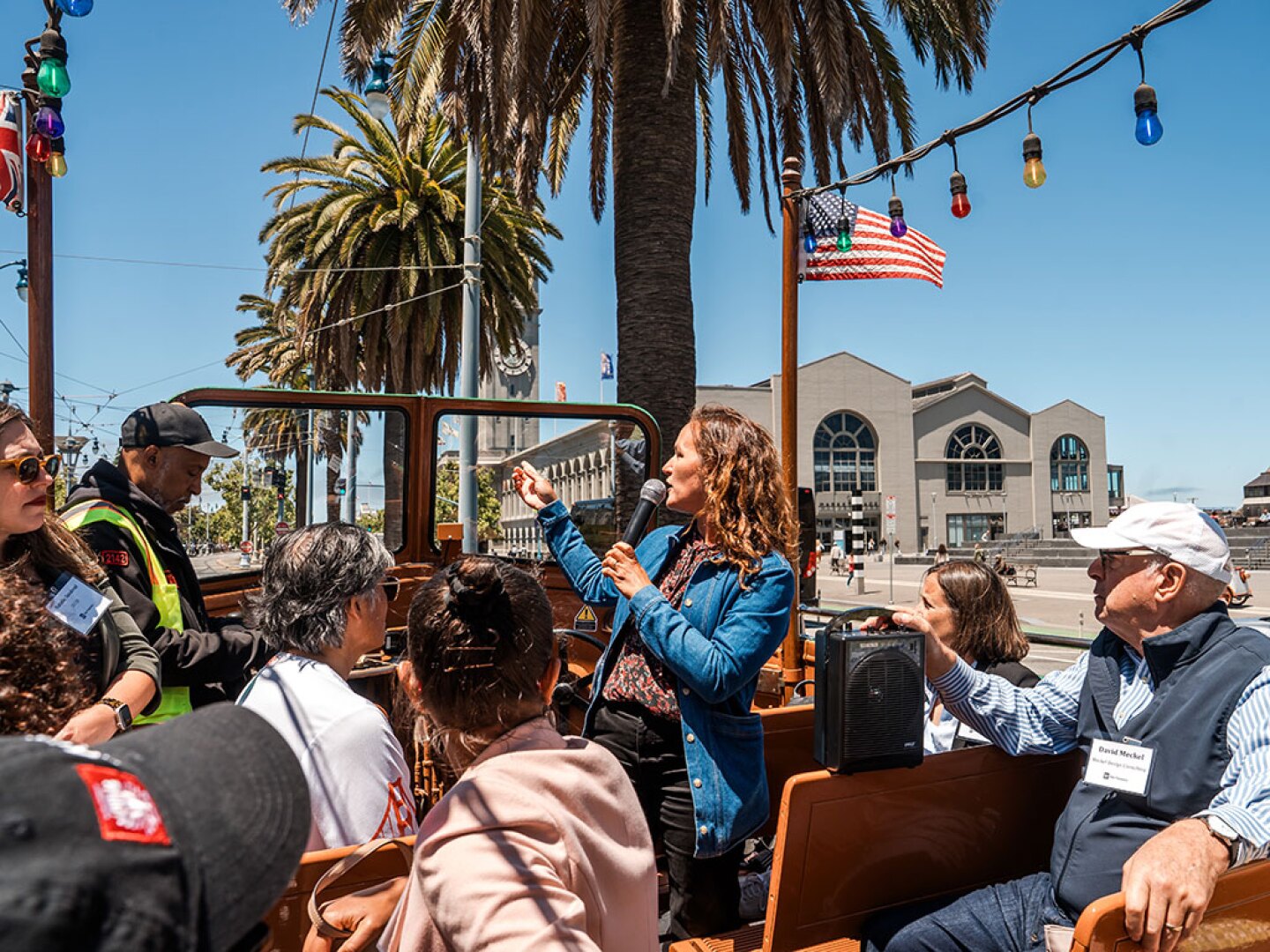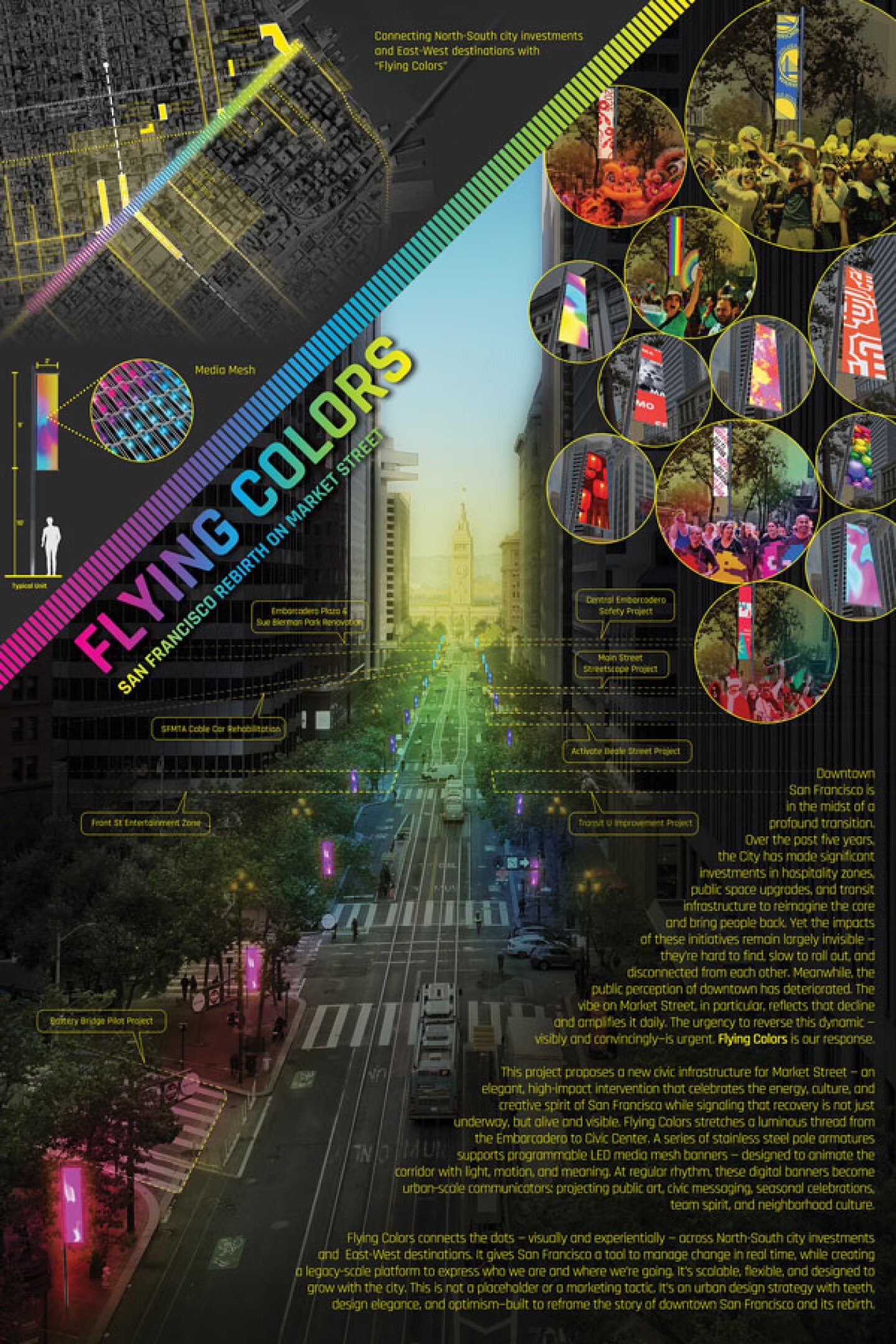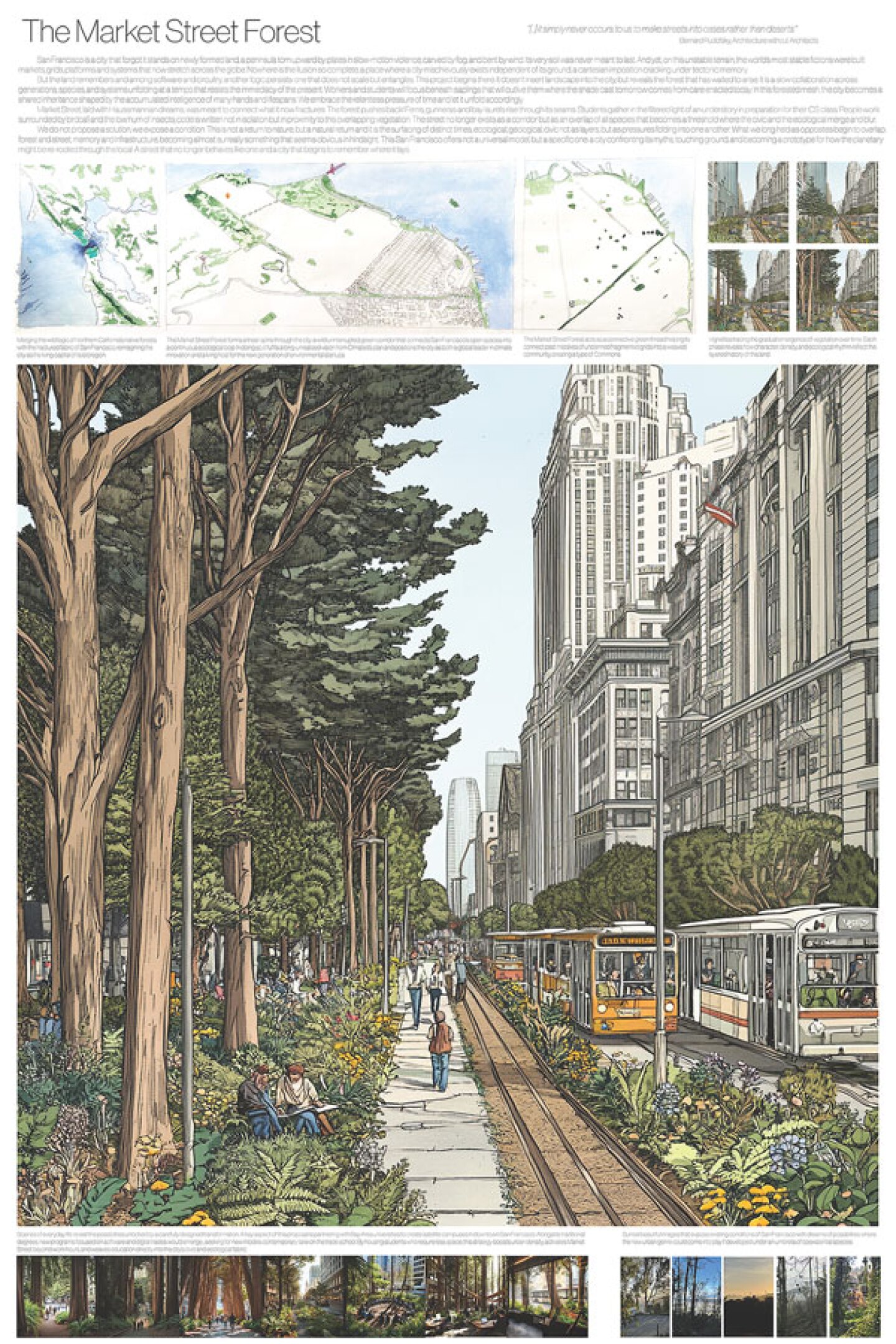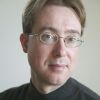
The Market Street Reimagined competition attracted 173 submissions from nine countries, igniting discussions on the future of downtown San Francisco. This collaboration between ULI San Francisco, the Civic Joy Fund, and the municipality distributed $100,000 in prizes.
(ULI San Francisco/Kathleen Sheffer)
For decades, civic leaders have tried to revitalize Market Street, San Francisco’s central thoroughfare, only to see their efforts founder. “I sometimes call it the great white whale of San Francisco,” says Eric Tao, managing partner at L37 Development in San Francisco and co-chair of ULI San Francisco. “Every new mayor, every new planning director, every new economic development director has chased that white whale.” This year, however, an international competition of ideas hosted and run by ULI San Francisco, with support from the ULI Foundation, generated fresh momentum for reimagining the boulevard. The competition drew 173 submissions from nine countries and sparked new conversations about the future of downtown San Francisco.
The Market Street Reimagined competition, which distributed $100,000 in prizes, represents a collaboration between ULI San Francisco, the Civic Joy Fund, and the municipality. The competition’s roots trace back to a 2023 ULI Advisory Services Panel (ASP) that Tao co-chaired alongside Kate Collignon, partner at HR&A Advisors. The panel offered concrete recommendations for revitalizing San Francisco’s downtown core after the pandemic and the rise of remote work and e-commerce left many storefronts and offices vacant.
The panel’s recommendations addressed everything from zoning modifications to public space improvements. The city subsequently adopted many of these recommendations, which have proved successful, Tao says. Foot traffic on Market Street remains still stubbornly low, though, and many storefronts are empty.
Before construction of the San Francisco–Oakland Bay Bridge, Market Street was the city’s commercial spine, Tao says: “The Ferry Building would receive goods from merchants in the East Bay, and businesspeople and commerce would travel up Market Street.” The rise of the automobile and the introduction of underground rapid transit systems paradoxically contributed to Market Street’s decline, even as they served the broader metropolitan area.
From ASP to ideas competition
The competition was open to “residents, business owners, urbanists, optimists, visionaries, community builders, students, professionals, and anyone who can think in creative and unexpected ways,” according to the competition brief. To communicate their idea, entrants submitted a single, vertically oriented graphic panel in PDF and JPG formats.
Hosted by Mayor Daniel Lurie, the jury included prominent figures from the fields of architecture, transportation planning, and urban design. Their deliberations were informed by a walking tour of Market Street and conversations with city officials. The jury then reviewed the entries without knowing who submitted each one, which meant that prestigious firm names carried no weight—ideas had to stand on their own merit.
“One criterion was whether an idea could be done quickly and easily, with a relatively low budget,” says Stanley Saitowitz, founding principal at Natoma Architects in San Francisco and co-chair of the jury. “Another was whether it involved rehabilitation of existing structures. A third was whether it embodied a long-term, comprehensive rethinking of Market Street.” A large number of entries proposed adding landscape to the street, Saitowitz says: “That was an overwhelming direction that so many people were interested in.”
Candace Damon, co-chair of HR&A Advisors in New York City, and the other co-chair of the jury, has a similar take after reviewing all the submissions. “The narrative is very easy to tell,” she says. “The most important short-term imperative is to do away with either the reality or the appearance of ground-floor vacancies and activate the street. And then, over the longer term, the street needs to be rethought as a mixed-use street that is significantly greener.”
Damon found the diversity of entrants particularly compelling. “A very large number of entries were from the junior staff of major design firms,” she says. “That major design firms would have seen this competition as a growth opportunity for the younger staff—that was pretty cool.”
Alicia John-Baptiste, chief of infrastructure, climate, and mobility for the city of San Francisco, also served as a member of the competition’s jury. “There’s something particularly generative about issuing an open call to the community at large, to dream and imagine,” she says. “I was optimistic that what we would receive through the process would provide a spark of ideas of what could be. The competition was really successful in delivering that.” View All Submissions
Visions for transformation
The six winning entries—and the eight honorable mentions—reflect a wide range of approaches. Flying Colors by Bionic won the Award for Creative Wayfinding and Nighttime Animation with a proposal for programmable LED media mesh banners on stainless-steel pole armatures, a relatively fast and affordable way to add vibrancy through light, music, and dynamic content.
San Francisco’s Living Heart by Multistudio, Studio-MLA, Systematica, and Vibemap won the Award for Place-Making and Connected Neighborhoods with a proposal to remove automobiles and certain bus lines to prioritize streetcar and pedestrian mobility. New trees would provide shade, and zones would be designated for different kinds of activities.
The Market Street Forest by SUR, which won the Award for Visionary Ecology and Urban Greening, calls for remaking the thoroughfare into a linear forest linking the city’s open spaces and shading the street with its canopy.

San Francisco’s Living Heart proposal by Multistudio, Studio-MLA, Systematica, and Vibemap won the Award for Place-Making and Connected Neighborhoods by prioritizing streetcar and pedestrian mobility over automobiles and certain bus lines, featuring new tree plantings for shade and designated activity zones.
(Multistudio)
Winner of the Award for Spatial Innovation and Adaptive Urban Form, Asymmetry in Balance by SWA Group, would place a green promenade on the street’s sunnier north side and, on the shadier south side, a “mobility boulevard” dedicated to public transit, bicycles, and scooters.
SITELAB urban studio’s 4 Mile Bench won the Award for Radical Hospitality and Fast, Inclusive Public Space. The proposal challenges the trend of removing seating to deter loitering. Instead, it envisions a continuous, winding four-mile bench that would offer respite for everyone. The structure is designed to be assembled swiftly from off-the-shelf components.
The bench proposal was one of several that SITELAB developed after holding a collaborative session that invited everyone at the firm to bring ideas, says Laura Crescimano, principal at SITELAB, which has its office one block from Market Street. SITELAB senior associate Alyssa Garcia says she asked everyone, “What if it was all about ‘care’? The team doubled down on that.”

Yelamu Park on Market Street, envisioned by Saadi Halil, has won the Sir Norman Foster Innovation Prize. The project focuses on sustainability, creating a green corridor for pedestrians and cyclists while integrating the F Market electric light rail line without overhead wires, enhancing the urban environment in San Francisco.
(Saadi Halil)
SITELAB had already teamed with the Downtown San Francisco Partnership to develop the Public Realm Action Plan for a Reimagined Downtown San Francisco, which informed the firm’s approach. “We knew there’s very little seating in the downtown area,” says Crescimano. “People perch on ledges and planters. The idea of care—supporting families, supporting tourism, supporting workers, supporting joy and fun—we really liked that—not just for the obvious reasons, but also because it’s the spirit of San Francisco to embrace all.”
Norman Foster, founder and executive chairman of Foster + Partners, selected Yelamu Park on Market Street as the winner of the Sir Norman Foster Innovation Prize. The proposal, by Saadi Halil, co-owner of San Francisco’s Hometown Creamery and principal of Sequoia: Biomimicry Education and Advocacy, envisions a green corridor dedicated to pedestrians and cyclists, with the F Market electric light rail line running between the park and sidewalk without overhead wires. The long park would vary by block and include meandering walkways surrounded by lush native plants, a children’s playground, a community urban garden, an avenue of trees, plazas, and greenbelts.
Halil proposed using carbon-sequestering and porous cement, underground water capture and filtration systems, and native plant species to create both environmental and social benefits. “The proposal is built around adaptiveness, urban resilience, regeneration, efficiency, ecological balance, and multifunctionalism,” Halil says.
His proposal’s name honors the Yelamu, the Ohlone group that originally inhabited the San Francisco Peninsula. After winning the Foster Prize, Halil reached out to leadership in the Association of Ramaytush Ohlone. “I wanted to make sure that there was genuine conversation and collaboration,” Halil says. “The idea of having it be a platform for education and awareness, with information about the land and people—past and present—and dedication to similar values, seemed to resonate.”
A model for other cities
Cities across the U.S. face similar challenges, with downtown cores hollowed out by remote work, online shopping, and changing urban patterns. Architecture critic Inga Saffron of the Philadelphia Inquirer—who accompanied the jury on its Market Street tour as a guest of one of the jurors, former San Francisco Chronicle critic John King—sees potential for other cities to benefit from similar competitions.
“We have a Market Street in Philadelphia, with almost the identical geographic niche within the city, and with the same uses, the same problems,” Saffron says. “Every big city has this problem, even New York City: We will never fill all our ground-floor retail the way we did in the old days. What are we going to do with it? How are we going to activate our streets?”
Saffron highlights the potential for converting older office buildings to residential use as part of the solution. “People need housing, but the suburbs are very restrictive in their zoning and permitting of new housing,” she says. “Cities have all these older office buildings that can be converted to housing. Getting people to feel safe downtown, changing the vibe, changing the perception, that’s what this competition was all about.”
Halil says that if ideas from the competition were realized and became successful, he feels that would do more than just revitalize Market Street: “San Francisco has a unique position as a small city with considerable money and international recognition, and a successful execution could be an example for other cities around the world.”
Tao adds that, in particular, holding a competition such as this one, on the heels of an ASP, is a powerful model: “You have a very regimented, disciplined approach through the ASP, using the kind of experts that ULI can bring, and then you balance that with an international competition of ideas—no limitations, no history, no guidelines. You combine the two, that might be something that can be replicated to achieve results that just might work.”
Natalie Sandoval, executive director of ULI San Francisco, agrees. “ULI can serve as both a resource for cities to address specific challenges and a catalyst for bold ideas and visions that allow local government to think outside the box and dream big,” she says. “I see this as one of ULI’s unique strengths.”
From vision to implementation
The exhibition at the Ferry Building, which ran July 23–August 8, drew crowds and generated public discussion. Now, the ball is in the city government’s court.
“What’s important to us is to take the momentum that came from the ideas competition and carry that into the work the city is now doing,” John-Baptiste says. “What could we incorporate from these concepts in the shorter term? The redesign of a street, particularly something as iconic as Market Street, can become a 10-year endeavor with a tremendous amount of planning, and then maybe you start to realize a vision over the course of 15 years. Given the moment that we’re in, we want to bring some of this energy and creativity onto the ground in a much shorter period.”
The planning department is evaluating the entries for feasibility, implementability, and adaptability, she says: “Within the next couple of months, we’ll have a sense of where we might go with the concepts.”
The Civic Joy Fund is actively pursuing private fundraising to activate some winning ideas, Tao notes. Presentations on the winning submissions at the 2025 ULI Fall Meeting in San Francisco will expand the conversation beyond that city.
“We’re ahead of the curve here in terms of the demise of the central office function,” Saitowitz says. “San Francisco is a relic of the era of split zoning, which had separate work areas, separate manufacturing areas, separate living areas—a modernist way of thinking about the city in terms of its functioning, rather than in terms of community. The transformation that we are involved in now—where the downtown is going to become a mixed-use, more neighborhood-like place—is going to happen to other cities that have the same separation of living and working.”
For Tao, the competition represents San Francisco’s return to its roots. “We’ve always been a city to celebrate innovation, great ideas, moon shots. Who would have ever thought, 10 years ago, that you would let a stranger drive you around, or that you would live in a stranger’s bedroom and pay him money instead of [paying] a hotel? Those ideas all came from here.”










